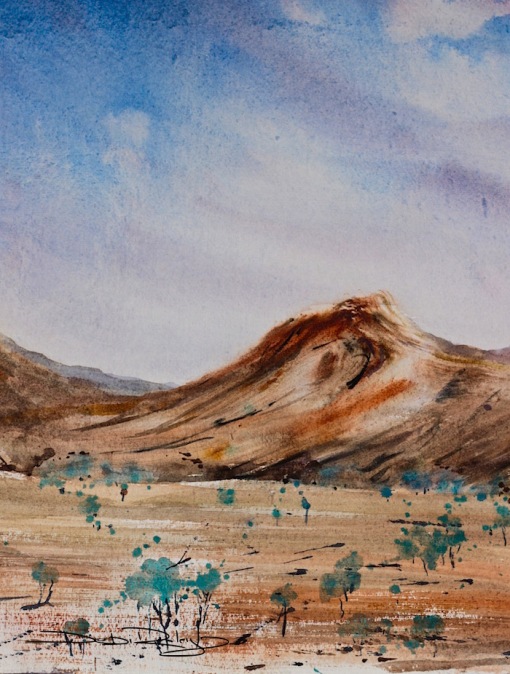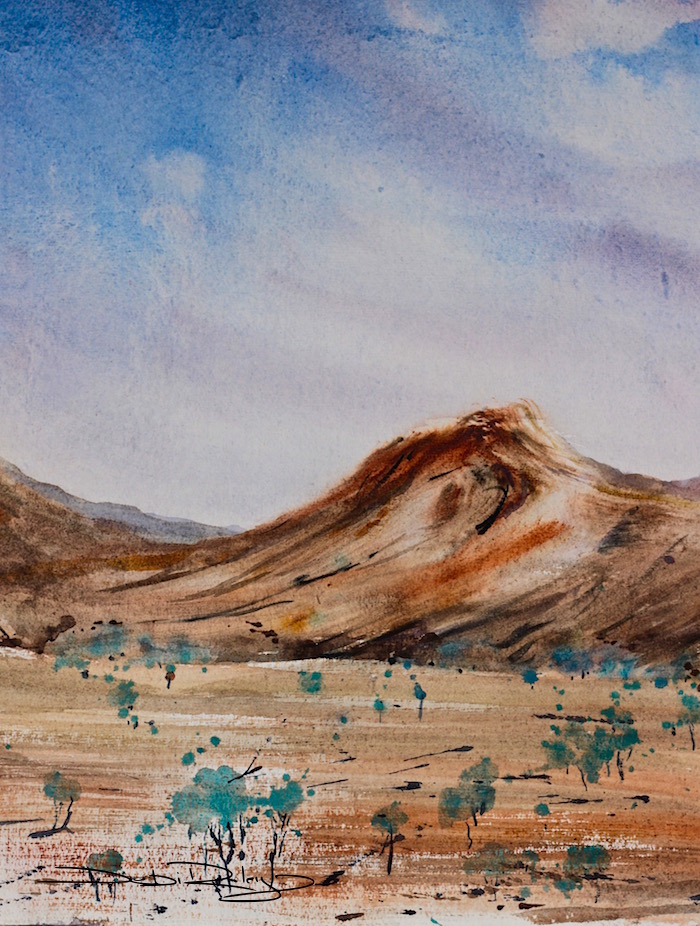There are easier ways to create and paint landscapes in watercolours. With these basic techniques and processes that I use when I’m in the midst of creating a painting, you’ll find landscapes a little less troublesome next time you go to paint!

Process of Painting – Watercolour Mountains
Step One Deciding the subject and the paper format, vertical or horizontal
Step Two Deciding the style of painting approach, Impressionist, interpretative, botanical, abstract, traditional, etc
Step Three Deciding if the subject will or won’t have a background
Step Four Deciding which watercolour technique to use for the Background, Middleground, Foreground and the Focal Point
Step Five Deciding which paints I’ll be using to mix and blend, keeping to a Limited Palette
Step Six Clarifying all my shapes, and their tonal values
I remember to paint the background first, working my way to the middle ground, then the foreground, then finally… I will paint the Focal Point.
I paint my biggest shapes first, progressing to the smaller ones. Last will be the Focal Point.

In this painting the sky was done using a wet in wet technique (cobalt and permanent rose mix) The hills and mountains were created using a charging technique and then glazing with burnt umber, burnt sienna, permanent rose. The foreground was dry brushed using burnt sienna and umber, then splatter with umber mixed with rose. The tree foliage greenery was cobalt teal, in a splatter technique.
Process of Painting – Watercolour Techniques
Beginners, here is an easy breakdown of which Watercolour Techniques are best placed where.
BACKGROUND: wet in wet watercolour technique for skies works wonderfully; a graded wash for watercolour skies is also excellent; successive glazes can work if one is of a patient personality.
MIDDLEGROUND: Charging is a fantastic watercolour technique for painting mountains and hills; graded washes will work as well; glazes work fine also.
FOREGROUND: Texture Techniques such as Dry brush, Splatter, Glad wrap, Scraping and Gouging, etc create wonderful detail and texture; graded washed going from dark at the base to paler further away are excellent watercolour techniques to use for foregrounds.
Beginners Process of Painting – Choosing Colours
I have found that two main things really determine the colours chosen for the subject, my mood on the day and how I dialogue with the specific subject.
The initial response is to think that, of course the subject’s colour must be the #1 deciding factor. It influences the choice, just to a lesser degree.
Why? For one thing, you are drawn to one subject over another predominantly based on Colour. Humans like colour. So if on a particular day your eyes linger more on the sunset than the green boat, its a safe bet to say that its not necessarily the boat you dislike or the sky you prefer but it is the Colour of the one over the other.
Colour
Mood will play a huge role in the colour you prefer on a given day as well. Grumpy, sad, playful, nostalgic, cheerful, energized, whatever you are feeling – it is going to be expressed somehow, in your palette colours of the day. You can deliberately, knowingly change your mood. By specifically choosing colours that are cheerful, bright, sunny, uplifting when you are low. Or if you’re too excited, by choosing mauves, greens, aquas that will calm, cool, soothe and relax.
Colour creates within us a visceral response. We will ‘like’ a colour because of how it makes us respond, whether we realise this or not. For artists, every day is different. One day I might like mauve, the next day it could make me shudder.
Mixing
Its a great idea to mix your own greens, oranges, purples, greys, blacks from the colours you are using. (Your tube of ultramarine, permanent rose, winsor lemon, prussian blue, cobalt blue.) You avoid mud and discordance this way.
Paynes grey is a dull colour that deadens everything it touches. It lacks warmth and coolness, its just ‘flat.’ If you want a grey or charcoal black – just mix ultramarine with burnt sienna. This is a wonderful watercolour colour mixing blend that is Very very easy.
Sap/Hookers green looks like a screeching banshee got loose in the trees rather than creating some nice natural foliage greens that blend into the environment.
If you need a tropical type of green, mix winsor lemon py175 with prussian blue b27 or with cerulean pb33 or with phalo blue pb15. That will give you the bright clean green with ease.
Opera is another flashy colour that has been recommended by many, yet it fails to go the distance. It fades away and isn’t lightfast as the above mentioned colours. Beginners are often drawn to these types of colours because they are ‘bright’ or ‘dark.’ Just a word of caution – don’t be drawn in by a bright shiny pretty colour. Find out how it reacts with other paints, how long it lasts, if its just a flash in the pan!
Yes, I know, a lot of instructions, books, etc. list off these tubes of premixed colours to go and buy. They do the watercolour beginner a great disservice. Beginners take it to heart and believe this information ….getting into some bad habits that are difficult to get out of. Beginners will then often wonder, why their colours are always muddy, why they can’t get many colour mixes from their paints, why their paintings aren’t working. Little realising that its not them, its their Paints.
Beginners Watercolours- the Key To Success
I do have to say one thing, as much as I love Colour, colour does not override Tonal Values. You must always have a good range of tones in the painting. Tone trumps colour.
Having adequate Light tone, Mid tone, Dark tone throughout your painting is the number one criteria for a successful painting.

Do a lot. Paint as much as you can. Paint skies, more skies, more skies. Get so proficient at the skies that when you move onto the mountains you’re not even thinking about the sky, its all about The Mountain. And then repeat…. Paint mountain, after mountain, after mountain. Its not boring at all. It becomes fun, calming, relaxing and quite enjoyable.
Keeping the edges slightly blurred in some places, so that its not completely encased in hard sharp edges all over. Let the eye have some relaxation by providing some soft edges here and there.
And Believe me, you do get better the more you practice!


Such wonderful tips and advice. thank you Deb
LikeLiked by 1 person
hi Jodi, thank you very much. I’m glad to share the information with everyone!
LikeLiked by 2 people
Preach! Love this, Debi! You should write a book. I hope you do. In yesterday’s painting, I put colors in the mountains one doesn’t typically see, just because I like them and the colors all played well together also. Interesting your notes about color here. Thanks again for a most informative post! 💜💜💜
LikeLiked by 1 person
Thank you Laura! your sky was delightful & the colours of the mts looked nice and varied within the forms, well done 🙂 I’m glad you enjoyed my post Laura
LikeLiked by 1 person
Thank you! You inspire me, my sweet!! 💜💜💜
LikeLiked by 1 person
fantastico! you are Wellcome 🙂
LikeLiked by 1 person
Wonderful!
LikeLiked by 1 person
David, Thank you for your kind comment on the post, I appreciate it!
LikeLiked by 1 person
Beautiful Debi! Really useful information on color.
LikeLiked by 1 person
Thank you Mary! I should do more posts on the individual colours, the mixes, the ‘goodies’ and the ‘not so good ones’ – with a why they are a problem as well. Perhaps I will soon 🙂
LikeLiked by 1 person
You should write a book about the water color techniques, Debi. Wonderful paintings and interesting story. The first painting reminds me a bit of Greece. Only the trees should be olive trees. Have a wonderful day, regards Mitza
LikeLiked by 2 people
Who needs a book on how to paint when we have your blog? Lessons from the Great Masters begins right here 🙂
LikeLiked by 2 people
You are very kind. Thank you Andrew for your wonderful vote of confidence! I’m always so delighted to share what information I have and hope it helps; but I’ve a journey to go before I’d call myself ‘master’ !
LikeLiked by 1 person
I would say your there 🙂
LikeLike
thank you for such a lovely compliment!
LikeLiked by 1 person
My pleasure
LikeLike
This is excellent advice. Thanks!
LikeLiked by 1 person
my pleasure, glad to share! Thank you for your kind words and your feedback 🙂
LikeLike
I was blog hopping and came across your wonderful site! You are so creative! I wish I can create art as good as you can. Alas, I don’t have the talent.
LikeLiked by 1 person
Thank you so much, that is very kind of you! I thought your website quite creative and lovely, perhaps you have some inner creativity that in there…. hidden, at the moment. Waiting. 🙂
LikeLiked by 1 person
Really like your Watercolour Mountains. Thanks for stopping by and giving a like to my illusion of creativity.
LikeLiked by 1 person
Thank you! and you’re very welcome 🙂 cheers, Debi
LikeLiked by 1 person